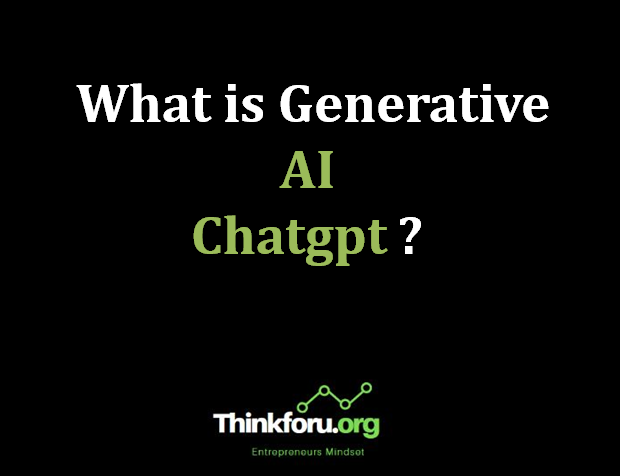Generative AI, such as ChatGPT, refers to artificial intelligence models that are capable of generating human-like text or content. These models use deep learning techniques, specifically recurrent neural networks (RNNs) or transformer architectures, to understand and generate responses that resemble natural language.
ChatGPT, developed by OpenAI, is a specific implementation of generative AI based on the GPT (Generative Pre-trained Transformer) architecture. GPT models are pre-trained on a vast amount of diverse data from the internet, allowing them to learn patterns, context, and grammar of human language. ChatGPT, in particular, is designed for natural language understanding and generation in a conversational context.
Users can interact with ChatGPT by providing prompts or messages, and the model generates responses based on its training data. It has been fine-tuned to be used as a chatbot, answering questions, engaging in conversations, and providing information. It's important to note that while ChatGPT can generate coherent and contextually relevant responses, it may not always exhibit perfect understanding, and its output should be interpreted with caution.
Generative AI, including models like ChatGPT, operates based on the principles of natural language processing (NLP) and machine learning.
Here are some key aspects to understand:
1. Pre-training and Fine-tuning:
Models like GPT undergo pre-training on a large corpus of diverse text data. During pre-training, the model learns the intricacies of language, grammar, and context. After pre-training, the model can be fine-tuned on specific tasks or domains to enhance its performance in certain areas.
2. Transformer Architecture:
GPT and similar models utilize transformer architectures, which have proven to be highly effective for sequence-to-sequence tasks in NLP. Transformers allow the model to capture long-range dependencies and contextual information, making them well-suited for tasks like language understanding and generation.
3. Tokenization:
The input text is tokenized into smaller units (tokens) before being processed by the model. Tokens can be words, subwords, or characters. This tokenization helps the model handle the vast vocabulary and structure of human language more efficiently.
4. Contextual Learning:
One notable feature of GPT is its ability to understand and generate text based on context. The model doesn't just look at the current word but considers the entire context of the input text to generate coherent responses. This makes it effective in tasks requiring context-awareness, such as conversation.
5. Limitations:
While generative AI models like ChatGPT can produce impressive and contextually relevant outputs, they also have limitations. They may generate incorrect or nonsensical information, be sensitive to input phrasing, and potentially exhibit biased behavior based on the data they were trained on.
6. Ethical Considerations:
The use of generative AI raises ethical concerns, including the potential for misuse, spreading misinformation, or unintentionally generating biased or harmful content. Researchers and developers are actively working on addressing these challenges to make AI systems more responsible and ethical.
Here are some more aspects related to generative AI, particularly ChatGPT:
1. OpenAI's GPT Series:
OpenAI has released several iterations of the GPT series, with each version being an improvement over the previous one. As of my last knowledge update in January 2022, GPT-3 was the latest version, known for its large-scale architecture with 175 billion parameters. Each new version tends to exhibit better language understanding and generation capabilities.
2. Prompt Engineering:
Users interact with generative AI models by providing prompts or input text. Crafting effective prompts is crucial for obtaining desired outputs. The same model may produce different results based on how a question or statement is phrased. Users often experiment with different prompt formulations to achieve the desired response.
3. Conditional Generation:
Generative models can be conditioned on specific input information or context to tailor their responses. For example, a prompt could include information like a specific context, style, or tone, guiding the model to generate output aligned with those criteria.
4. Applications:
Generative AI models like ChatGPT find applications in a variety of domains. They can be used for creating conversational agents, virtual assistants, content generation, language translation, and more. Their versatility allows for adaptation to different tasks with appropriate training and fine-tuning.
5. Research and Development:
Ongoing research in the field of generative AI aims to address limitations and improve model capabilities. Researchers explore techniques to enhance model interpretability, reduce biases, and make these systems more robust and reliable in various real-world scenarios.
6. API Access:
OpenAI has made ChatGPT accessible through APIs (Application Programming Interfaces), allowing developers to integrate the model into their applications, products, or services. This enables a wide range of creative and practical use cases.
7. User Feedback:
OpenAI encourages user feedback to understand the strengths and weaknesses of their models. Learning from user interactions helps improve the models and address issues such as generating inaccurate information or inappropriate content.
Generative AI continues to be an active area of research, and its applications and capabilities are likely to evolve over time as new models and techniques are developed. Keep in mind that developments in the field may have occurred since my last update in January 2022.
It's important to keep in mind that the information provided here is based on my knowledge as of January 2022, and there may have been advancements or updates in the field since then.
More Related to Generative AI
